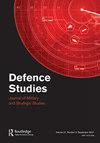Estimating the alliance effect: a synthetic control approach
Q1 Arts and Humanities
引用次数: 1
Abstract
ABSTRACT In a time of rising threat, recurring discussions about burden sharing within NATO and twenty years after the start of the “war on terrorism,” I explore a novel idea in the field of alliance and defense spending: the effect of alliance membership on defense spending in response to a threat. Instead of estimating the determinants of defense spending or burden sharing among members, this paper focuses on two types of states (small and large) and how alliance membership shapes their response to threat. Using the synthetic control method, I create a comparison unit for each type consisting of a weighted average of non-NATO, European countries. 2001 is considered as the starting year of widespread threat, caused by a sudden increase in transnational terrorism. This way, I can estimate the “alliance effect.” I find that both types of states have stronger (positive) response to threat as NATO members, compared to if they would not have been part of the alliance.联盟效应的估计:一种综合控制方法
摘要在威胁不断加剧、北约内部关于负担分担的反复讨论以及“反恐战争”开始20年后,我在联盟和国防开支领域探索了一个新的想法:联盟成员国身份对应对威胁的国防开支的影响。本文没有估计国防开支或成员国之间分担负担的决定因素,而是关注两种类型的国家(小型和大型),以及联盟成员国如何塑造他们对威胁的反应。使用综合控制方法,我为每种类型创建了一个比较单元,由非北约、欧洲国家的加权平均值组成。2001年被认为是跨国恐怖主义突然增加所造成的广泛威胁的开始年份。通过这种方式,我可以估计“联盟效应”。我发现,与不加入北约的国家相比,这两种类型的国家作为北约成员国对威胁的反应都更强(积极)。
本文章由计算机程序翻译,如有差异,请以英文原文为准。
求助全文
约1分钟内获得全文
求助全文

 求助内容:
求助内容: 应助结果提醒方式:
应助结果提醒方式:


